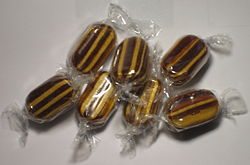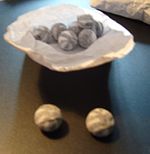- Humbug (sweet)
-
Humbugs are a traditional hard boiled sweet available in the United Kingdom,[1] Ireland, Canada, Australia and New Zealand. They are usually flavoured with peppermint[2] and striped in two different colours (often brown and tan). They have a hard outside and a soft toffee centre.[1] Humbugs are typically cylinders with rounded ends wrapped in a twist of cellophane,[citation needed] or else pinched cylinders with a 90-degree turn between one end and the other (shaped like a pyramid with rounded edges), loose in a bag.[2] Records of humbugs exist from as early as the 1820s and they are referred to in the 1863 book Sylvia's Lovers as being a food from the North.[3]
They are more often eaten in winter than summer.[citation needed] The name of the sweet is not related to the phrase "Bah, humbug" derived from Dickens' A Christmas Carol. That expression implies a general dissatisfaction with the Christmas season. However, offering humbugs around Christmas time is now seen by some as humorous or ironic, and was featured in an episode of Blackadder in this manner.
Contents
Manufacture
A mixture of sugar, glycerine, colour and flavouring is heated to 145°C. This is then poured out and stretched and folded many times. The stripes originate from a smaller piece of coloured mixture which is folded in to the main mixture. The mixture is finally rolled in to a long, thin cylinder and sliced into segments.[4]
Bulls-eyes
A similar sweet is "bulls-eye" which has black and white stripes like a humbug but is spherical like an aniseed ball. These are peppermint flavoured and are also known as bullets in the UK as they are similar in size to smoothbore musket balls.[citation needed]
See also
References
- ^ a b Nick Patch (24 August 2009). "Arctic Monkeys new disc shows maturity". Times and Transcript. http://timestranscript.canadaeast.com/lifetimes/article/769837. Retrieved 25 January 2011.
- ^ a b Davidson, Alan; Davidson, Jane; Saberi, Helen (2006). Jaine, Tom. ed. The Oxford companion to food. OUP Oxford. ISBN 0192806815. http://books.google.co.uk/books?id=JTr-ouCbL2AC&pg=PA390&lpg=PA390&dq=humbug+sweet+-bah+-buy&source=bl&ots=1014qf6fze&sig=5kJPKfi0LVpOVCO-3Ajuo0JzJXc&hl=en&ei=gCQ_TaikDMK08QPlt8X6CA&sa=X&oi=book_result&ct=result&resnum=7&ved=0CEQQ6AEwBjisAg#v=onepage&q=humbug%20sweet%20-bah%20-buy&f=false.
- ^ Ayto, John (1990). The Glutton's Glossary. Routledge. ISBN 0415026474. http://books.google.co.uk/books?id=vAQOAAAAQAAJ&pg=PA144&dq=humbug+sweet+-bah&hl=en&ei=CmY_TYSWAcWQswbO9cmNBQ&sa=X&oi=book_result&ct=result&resnum=5&ved=0CEEQ6AEwBDgy#v=onepage&q=humbug%20sweet%20-bah&f=false=.
- ^ Alex Renton (10 September 2009). "Humbugs, mints, gums and our Top 20 sweets". The Times. http://www.timesonline.co.uk/tol/life_and_style/food_and_drink/real_food/article6827812.ece. Retrieved 25 January 2011.
Traditional British sweets Aniseed ball · Aniseed twists · Apple drop · Army & Navy Sweets · Barley sugar · Flying saucer · Humbug · Milk bottle · Pear drop · Pontefract cake · Soor ploom
Categories:- British confectionery
- Confectionery stubs
Wikimedia Foundation. 2010.


